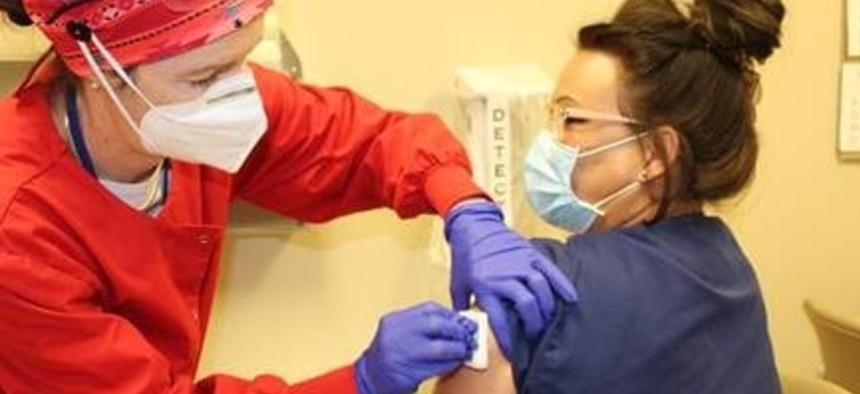
Sugar Young, outpatient department registered nurse, receives a COVID-19 vaccine at the Kayenta Health Center in Arizona on December 15, 2020. Indian Health Service
Indian Health Service Seeks to Reverse Longstanding Shortfalls With Staffing Surge
Agency will use COVID-19 relief funds for "game-changer" hiring push.
The Biden administration has announced it will soon invest $240 million into the Indian Health Service workforce, an injection many observers have requested for years and with the potential to be a “game changer” for the agency.
The funding is part of a $1.8 billion cash infusion the health service will receive as part of COVID-19 relief funds provided in the American Rescue Plan. The workforce piece will go toward recruiting and hiring efforts, as well as retention of existing staff. IHS said it will also create a new career opportunities website and improve the processing of student loan repayments for staff. The agency was hit particularly hard during the pandemic, struggling to provide adequate care to Native American populations disproportionately affected by the COVID-19 outbreak. In recent months, IHS has distributed 1.4 million doses of COVID-19 vaccines to its staff and the population it serves.
“Investing in our workforce and providing our team with the facilities, equipment, supplies, and funds they need is absolutely critical to ensuring our ability to fulfill the IHS mission of raising the physical, mental, social and spiritual health of American Indians and Alaska Natives to the highest level," said IHS acting Director Elizabeth Fowler.
IHS has struggled for years with maintaining adequate staffing, in part due to a lack of funding. The Government Accountability Office found in 2018 the vacancy rate among physicians, nurses and other care providers at the agency was at 25%. IHS officials have said those shortfalls have vast negative impacts on the agency, including patient access to care, quality of care and employee morale.
“In an agency that has multiple challenges, the number one challenge by far is the workforce,” said Mary Smith, who led IHS from 2015 to 2017. She stressed the impact that high turnover and contracted medical providers have on care IHS can deliver. “The biggest complaint we hear from patients is that every time they go to a facility there may be someone different there.”
Smith said she was pleased to see the Biden administration’s investment in the IHS workforce, saying retention efforts—including the student loan repayment process improvement—could go a long way at the agency.
“I think this will be great,” she said, adding it “could be a game changer.”
Asha Petoskey, an IHS spokesperson, said the agency will distribute the funds to its hospitals, clinics, education programs and community health representatives on a proportional basis.
“Each IHS, tribal, and urban Indian Health Program will determine how the funds will be used to support additional staffing needs, investments to their workforce, and recruitment and retention programs,” Petoskey said.
Smith added, however, simply adding funds for hiring will not solve all of IHS’ problems. She noted that IHS cannot pay its staff as much as the private sector, or even its federal partners at the Veterans Affairs Department. Rear Adm. Michael Weahkee, who led IHS during the Trump administration, brought that problem to Congress’ attention during his tenure.
Title 38 of the U.S. Code provides “authorities [that] enable the VA to compensate at higher rates,” Weahkee told a Senate committee in 2019. “Their benefits packages are much better than Title 5 and the hiring authority that we have within the IHS.” He added VA can get much closer to matching private salaries than IHS can.
Smith noted during her tenure, provider vacancies reached 40% in some areas. She added that some of her nurse recruiters reported they could not fill any openings if a VA facility in the area was also hiring. GAO found in its report that low pay, remote locations, insufficient housing, substandard housing and a "lack of entertainment opportunities” all contributed to IHS' difficulties in filling jobs.
Smith also decried the overall budget at IHS, suggesting—as many observers have for years—the agency is drastically under-resourced to serve the rapidly growing American Indian population. The agency has an annual budget of about $6 billion to operate a system of 25 hospitals and more than 100 total facilities serving more than 2.6 million eligible people. By comparison, VA received 16 times that amount for health care in fiscal 2020 to serve a population of only four times as many individuals. IHS has 15,000 employees, compared to 367,000 for VA.







